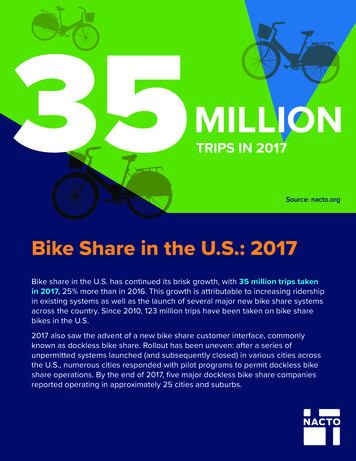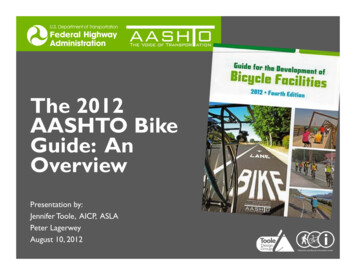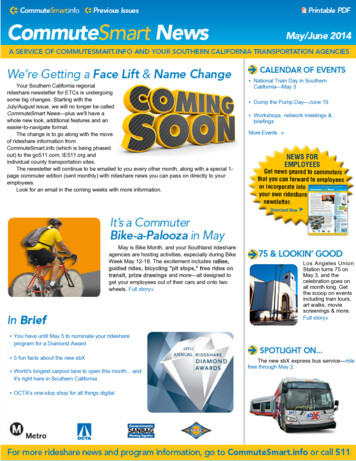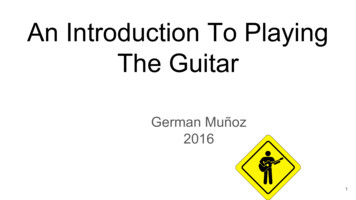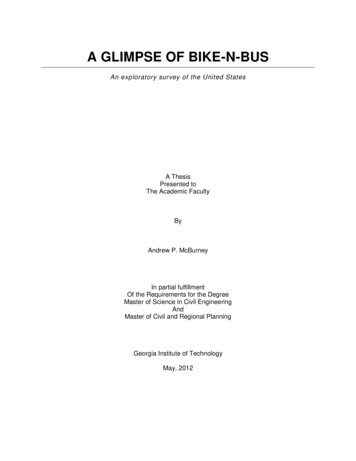
Transcription
A GLIMPSE OF BIKE-N-BUSAn exploratory survey of the United StatesA ThesisPresented toThe Academic FacultyByAndrew P. McBurneyIn partial fulfillmentOf the Requirements for the DegreeMaster of Science in Civil EngineeringAndMaster of Civil and Regional PlanningGeorgia Institute of TechnologyMay, 2012
A GLIMPSE OF BIKE-N-BUSAn exploratory survey of the United StatesApproved by:Dr. Michael D. Meyer, AdvisorSchool of Civil & Environmental EngineeringGeorgia Institute of TechnologyDr. Frank SouthworthSchool of Civil & Environmental EngineeringGeorgia Institute of TechnologyDr. Brian StoneSchool of City & Regional PlanningGeorgia Institute of TechnologyDate Approved: Friday, March 30, 2012
ACKNOWLEDGEMENTSI submit this thesis by the support of many people: Dr. Meyer, my advisor, has guided me through this process with great patience. Dr. Southworth and Dr. Stone have taken the time to review my work. My peers have shown me how to persevere in the trials of grad-school. My family has supported my education in Atlanta and encouraged me to “get it done.” My wife, Danae, helps me turn ideas into sentences when I get stuck. The taxpayers of Georgia and the USA have funded my master’s education.iii
TABLE OF CONTENTSACKNOWLEDGEMENTS . iiiLIST OF TABLES. viiLIST OF FIGURES . viiiSUMMARY . ixCHAPTER 1: INTRODUCTION . 11.1 Research Question and Hypotheses . 11.2 Structure of the Report . 31.3 Significance to Transport Policy . 4CHAPTER 2: RESEARCH CONTEXT . 52.1 How to Discuss Bike-n-Bus – A Suggested Lexicon . 62.2 Evolution of Bike-n-Bus Research . 92.2.1 Advocacy by Replogle .102.2.2 National Attention .122.2.3 Bike-n-Bus Studies – Martens and Hagelin .172.3 International Experience – Is the U.S. behind? .282.3.1 Japan .302.3.2 Denmark & Sweden.302.3.3 Germany .312.3.4 The United Kingdom .312.3.5 Netherlands .312.4 History of Bike-n-Ride in the United States .36iv
2.5 Benefits of Bike-and-Bus - Still Room for Growth .422.5.1 Gives Cyclists a Lift .432.5.2 Widens Rider Base for Transit .442.5.3 Competitive Alternative to Driving .47CHAPTER 3: METHODOLOGY .513.1 Agency Selection .513.2 Who Responded .543.3 Interview Description .583.4 Refining the Questions .603.5 Survey Questions and Responses .61CHAPTER 4: FINDINGS .674.1 Ways to Accommodate Bicycles.674.1.1 Bike-Load with Front-Mounted Rack .684.1.2 Bike-in-Bus .774.1.3 Bicycle Parking .804.2 Program Creation .824.2.1 Startup Dates .844.2.2 Outfitting the Fleet .854.3 Promotion to the Public .874.3.1 Educating Riders .874.3.2 Bike-to-Work Day .884.4 Collaborating with Other Organizations .894.4.1 Bicycling Advocates.894.4.2 Bicycle Advisory Committees .914.4.3 City and Regional Governments .94v
4.5 Hindrances to Bike-n-Bus Use .944.5.1 Unfavorable Climate and Terrain .944.5.2 Limited Capacity Leads to Turn-aways .984.5.3 Insufficient or Inadequate Bicycle Parking .1004.5.4 No Bikeable Routes .1024.5.5 Culture – Oddity in an Auto-centric World .1034.6 Users and Stakeholders .1064.6.1 Need for Performance Metrics? .1064.6.2 Bike-n-Bus Users .1094.6.3 Stakeholders - everyone else .1144.6.4 Unquestionable Rise in Popularity .115CHAPTER 5: CONCLUSION .1175.1 Vision of Potential .1195.2 How to Shape a BnB Program .1215.3 Takeaways for Policymakers .1255.4 Opportunities for Further Research .126APPENDIX.129REFERENCES .132vi
LIST OF TABLESTable 1 – Costs and Benefits of Bike-n-Bus (Hagelin, 2005) .23Table 2 – Distance Biked to and from the Bus (Hagelin, 2005) .25Table 3 – European bike-n-ride share by transit mode (Martens, 2004) .29Table 4 – Bike access as a function of city order, the Netherlands (Martens, 2004) .29Table 5 – Early Bike-n-Bus Programs ("Case Study No. 9," 1992) .41Table 6 – Benefits of Bike-n-Bus (Hagelin, 2005) .43Table 7 – Selected Cities by Region .54Table 8 – Responding Agencies .55Table 8 – Responding Agencies (Continued) .56Table 9 – Position of Survey Respondents within their Agency .59Table 10 – How to start a Bike-n-Bus Program (Doolittle & Porter, 1994).83Table 11 – European bike-n-ride trip purposes (Martens, 2004) .111Appendix – Sample Agencies and their Attributes . .129vii
LIST OF FIGURESFigure 1 – European bike access trip distances (Martens, 2004) .19Figure 2 - Bike Parking at Commuter Rail Station, Weesp, NL (Andy McBurney) .34Figure 3 – Bicyclists Returning from Rail Station in Evening, Kampen, NL (Andy McB.) .34Figure 4 – Bike Parking at a Bus Stop, Broek in Waterland, NL (from Google Maps) .35Figure 5 – Expansion of Bike-Load in the U.S. during the 2000s (Neff, 2008-2010) .40Figure 6 – Benefits of Bike-Transit Integration ("Bicycles & Transit," 1999) .50Figure 7 – FTA Regions ("Public Transit Agencies Fleet Size Greater than 200," 2009) .53Figure 8 – Map of Selected & Responding Cities .57Figure 9 – Startups Dates Reported by Respondents .84viii
SUMMARYBike-n-Bus includes any number of methods where bicycle serves as the access mode to someform of bus transit. This study examines bike-n-bus operations in the United States based ontelephone interviews with transit professionals from 33 transit agencies across the lower 48states. It reviews past trends in research and gives some history of bike-n-bus in the U.S. andabroad. A brief explanation of methodology is followed by a description of the various facets ofU.S. bike-n-bus operations, based on both interviews and the literature, with commentary bysurvey respondents.The study ends with a long term vision for bike-n-bus based on thecharacteristics of that mode-couple.Conclusions are addressed to various audiences: transit agency, community leader/ policymaker, and researcher.Included are suggestions for possible next steps in research andimplementation. These findings would be of interest to those studying transit and bicycle travel,developing travel demand models, managing a transit agency, or those with influence overbicycle policy and infrastructure.Most transit agencies have installed front-mounted bicycle racks on their entire bus fleet, andexpressed satisfaction that the amenity accommodates bicyclists. However, agencies havemade only moderate efforts to follow-up on this success. Studies suggest that cycling to transitcan be competitive with the private automobile in journey-to-work trips and attracts new riders totransit. Better bicycling infrastructure is the most significant way to increase the number of biken-bus riders. However, transit agencies seem reluctant to support these improvements.ix
CHAPTER 1: INTRODUCTIONBike-n-Bus includes any number of methods where bicycle serves as the access mode to someform of bus transit. This study examines bike-n-bus operations in the United States based ontelephone interviews with transit professionals from 33 transit agencies across the lower 48states.1.1 Research Question and HypothesesWhat is the maximum potential for bike-n-bus, and how much has this already been achieved?Because this survey is intended to be exploratory, hypotheses are in terms of what respondentsmay or may not mention: When and how have transit agencies adopted bike-n-bus accommodations?Agencies may have installed bike racks in the mid- to late- ‘90s, during the period whenbike-n-bus was receiving national attention, though literature from the American PublicTransit Association (APTA) suggests less than one-third of transit agencies installed bikeracks during the 1990s (Neff, 2008-2010). Respondents may mention funding retrofitswith money available through the Intermodal Surface Transportation Equity Act (ISTEA)or the Transportation Equity Act for the 21st Century. Do transit agencies have clear, written policies?While one might expect a transit agency to have clear written policies related to theirbike-n-bus program, these might take the form of rules bike-n-bus users are required toadhere to. Some of these rules might be related to issuing permits to allow bike-n-bususe.1
How have transit agencies worked with other groups to develop the bike-n-bus program?Agencies may have started their bike-n-bus program in response to pressure frombicycling advocacy. Others may have installed FMRs following the example of otheragencies. In either case, transit agencies may have needed to collaborate with outsidegroups in order to promote the program. Are agencies aware of which groups have an interest in bike-n-bus?Agencies may not be able to tell what sort of riders use bike-load, and assume thattransit users are the main stakeholder group. Do transit agencies measure the level of bike-n-bus use?Agencies may loosely monitor bike-n-bus use, as a means to report on the program’seffectiveness. Agencies may have adopted bike-n-bus as a way to increase ridership,but more likely installed racks in response to cyclists wanting greater mobility and easierpassage over hills and around bodies of water. Can transit professionals comment on what obstacles hinder greater bike-n-bus use?Transit professionals may have given casual thought to the obstacles of bike-n-bus use,though transit agencies are not likely to have researched this. According to Replogle,secure bicycle parking may be the greatest need in the U.S. (Replogle, 1984). How is it thought that bike-n-bus will evolve?Bicycling advocates may have proposed changes to the transit agency’s bike program,to better suit their needs. However, transit agencies may find bike-n-ride use too low towarrant further efforts.2
1.2 Structure of the ReportThe report is structured into five chapters. After the introduction, it covers existing literature,outlines the methodology of the study, and then proceeds into a direct discussion of bike-n-bus.The conclusion answers the research question and highlights key findings.The second chapter, entitled “Research Context,” includes five sections: the first on terminology,the second highlights key trends in research, the third section looks at international experience,and the fourth hones in on bike-n-bus in the U.S.The final section organizes all of thetheoretical benefits to bike-n-bus.Methodology is discussed in Chapter 3. Agencies were selected to be interviewed based on anumber of criteria, so the sample would be representative of the nation as a whole.Respondents were asked to participate in a 10 question telephone survey lasting 10 to 15minutes, with an email reply offered as an alternative. Along the way, it became apparent thatthe wording of some questions would need to be changed, to be more neutral. A generalizationof the response to each question is given, with results being discussed in more detail in the nextsection.The fourth chapter incorporates these findings, organized by topic, with existing literature.Sections follow a progression from the fundamental issues of accommodating bicycles toanswer broader questions about how bike-n-bus is used.It includes the various ways toaccommodate bicycles with bus transit, the dynamics of starting a bike-n-bus program, the effortrequired to publicize the program, and the on-going discussions with other groups concernedwith bike-n-bus. It further discusses the hindrances faced by would-be bike-n-bus users, andassesses who is likely to use BnB, as well as identify its other stakeholders.3
Conclusions, in Chapter 5, are divided into four sections. Having already portrayed a snapshotof bike-n-bus in the United States (through the end of 2008), the conclusion continues to lay outa vision of what bike-n-bus could be. This is followed with a roadmap for transit professionalsseeking to refine their agency’s bike-n-bus program. A third section gives tips for policy-makersfor how to regard bikes and buses as part of a combined network. Finally, remaining questionsare suggested for future research.1.3 Significance to Transport PolicyThis thesis is designed to facilitate the further of development of bike-n-bus. By capturing asnapshot of the current state of practice, and giving a thorough discussion of the different facetsof bike-n-bus, it is hoped that future BnB efforts can build upon the collective experience of theU.S. Moreover, by developing a vision of the potential for bike-n-bus, this report seeks toinspire greater innovation by providing a target to reach for. The conclusions of this report areintended to be practical take-aways for each of its three audiences. A framework is provided forthe transit professional, so they can assess the structure of the agency’s bike-n-bus system. Tothe decision-maker taking a higher-level view of the transportation system, the conclusion offerssome “rules of thumb” for bike-n-bus, by which they can plan. Finally, suggestions are made tothe academic on how changes to bike-n-bus programs in various transit agencies can besupported and coordinated through research. Inherent to the survey approach of this study(which asks transit professionals for their opinions) is the acknowledgement that human factorsalso contribute to the development of bike-n-bus. By examining, along with the mechanics ofbike-n-bus, the organizations behind it, both may be found to have room for improvement.4
CHAPTER 2: RESEARCH CONTEXTThe research context includes five sections: the first on terminology, the second highlights key
bike-n-bus was receiving national attention, though literature from the American Public Transit Association (APTA) suggests less than one-third of transit agencies installed bike racks during the 1990s (Neff, 2008-2010). Respondents may mention funding retrofits with money available through the Intermodal S

